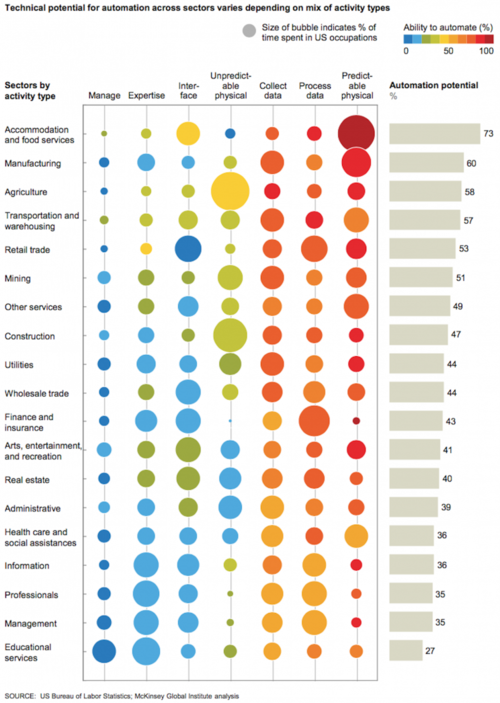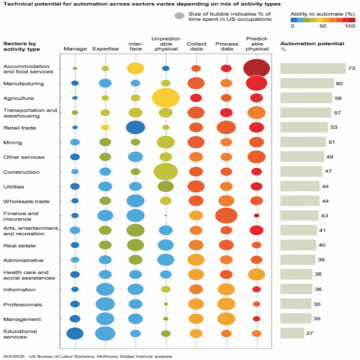This graphic shows how vulnerable every type of job is to automation
01-22-2017
Julia La Roche
There are lots of concerns that technological innovation like robots and artificial intelligence will destroy jobs.
This theme, however, will impact some types of jobs more so than others. Consulting firm McKinsey illustrated this in the graphic below, which was included in a new report on automation. The graphic breaks down job sectors and activity type that are ripe for technological automation.
The graphic shows that “accommodation and food services” secured the top spot as the sector most vulnerable to automation. These are jobs that involve preparing, cooking, serving food, preparing hot and cold beverages, and cleaning food preparation areas. The analysis noted that 73% of the activities workers perform in this sector have the potential to be automated. New technologies in the industry include self-ordering kiosks, robotic servers emerging, and Momentum Machines’ hamburger-cooking robot, which can reportedly cook and assemble 400 burgers per hour, the report noted.
Jobs that involve performing “predictable and physical” activities have the most potential to be automated. In addition to food services, both manufacturing and retail are also susceptible to automation.

Another area that’s likely to see automation is data collection and data processing. What’s noteworthy are these activities aren’t necessarily found in low-wage jobs. There are plenty of high-paying jobs that involve these tasks.
“Data processing is the second category most readily automatable (69%) and accounts for 16% of all the time spent working in the United States. That is followed by data collection (64% automation potential and 17% of time spent). These activities are common to almost all sectors, ranging from human resources staff recording personnel history to mortgage brokers filling in forms, medical staff compiling patient records, and accounting staff processing payments. These are not just entry-level or low- wage jobs; people whose annual incomes exceed $200,000 spend some 31% of their time doing those things as well,” the report noted.
Combined, technically automatable activities in food service, manufacturing, and retail make up 51% of the activities in the economy accounting for almost $2.7 trillion in wages, or about 46% of the total hours worked, the report found.
The graphic shows that educational services, management, and jobs held by professionals have the lowest automation potential. That said, automation will touch nearly every profession, but to varying degrees.
“While wage and skill levels are negatively correlated with technical automation potential (on average, occupations with higher wages and skill requirements have lower automation potential, reflecting some skill bias), a large amount of variation underlies the averages. Essentially all occupations, whether high skill or low skill, have some technical automation potential, including CEOs; we estimate about 25% of their work could potentially be automated, primarily such tasks as analyzing reports and data to inform decisions, reviewing status reports, preparing staff assignments, and so on,” the report said.
McKinsey’s report found that around 60% of all occupations world-wide have at least 30% of their activities that can be automated just by adapting existing technologies.
“Almost half the activities people are paid almost $16 trillion in wages to do in the global economy have the potential to be automated by adapting currently demonstrated technology, according to our analysis of more than 2,000 work activities across 800 occupations. While less than 5% of all occupations can be automated entirely using demonstrated technologies, about 60% of all occupations have at least 30% of constituent activities that could be automated. More occupations will change than will be automated away,” the report said.
To be sure, automation won’t happen overnight because of numerous hurdles. McKinsey notes that it could take decades before automation has a major impact.
“First is technical feasibility, since the technology has to be invented, integrated and adapted into solutions that automate special activities. Second is the cost of developing and deploying solutions, which affects the business case for adoption. Third are labor market dynamics, including the supply, demand, and costs of human labor as an alternative to automation. Fourth are economic benefit, which could include higher throughput and increased quality, as well as labor cost savings. Finally, regulatory and social acceptance can affect the rate of adoption even when deployment makes business sense. Taking all of these factors into account, we estimate it will take decades for automation’s effect on current work activities to play out fully.”
Of course, there are plenty of benefits of automation for businesses and economies, especially when it comes to productivity. That said, it gets tricky for policymakers when anxiety about lost jobs and reduced incomes arises.
“They should embrace the opportunity for their economies to benefit from the productivity growth potential and put in place policies to encourage investment and market incentives to encourage continued progress and innovation,” the report said, adding, “At the same time, they must evolve and innovate policies that help workers and institutions adapt to the impact on employment. This will likely include rethinking education and training, income support and safety nets, as well as transition support for those dislocated. Individuals in the workplace will need to engage more comprehensively with machines as part of their everyday activities, and acquire new skills that will be in demand in the new automation age.”

